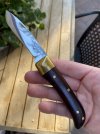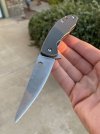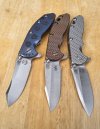-
The BladeForums.com 2024 Traditional Knife is ready to order! See this thread for details: https://www.bladeforums.com/threads/bladeforums-2024-traditional-knife.2003187/
Price is$300$250 ea (shipped within CONUS). If you live outside the US, I will contact you after your order for extra shipping charges.
Order here: https://www.bladeforums.com/help/2024-traditional/ - Order as many as you like, we have plenty.
You are using an out of date browser. It may not display this or other websites correctly.
You should upgrade or use an alternative browser.
You should upgrade or use an alternative browser.
Folder makers who focus on ultra high cutting performance
- Thread starter brancron
- Start date
jjg6319
Gold Member
- Joined
- Dec 19, 2011
- Messages
- 964
How about the original Spyderco Gayle Bradley. Since this knife is discontinued it is a little hard to find. I remember the interview with Gayle Bradley and I believe he use to compete in cutting competitions and kind of how he got to do his collaboration with spyderco.
ferider
Platinum Member
- Joined
- Jun 20, 2018
- Messages
- 15,149
- Joined
- Apr 12, 2006
- Messages
- 3,079
I cannot disagree with that! Here's my customer Dozier folder along with a paper-thin Anza (the blade stock is nearly as thin as an opinel), followed by a K390 Endura reground by Deep Cuts Cutlery:

What model dozier is that? Is it one of his customs or a collab?
- Joined
- Apr 12, 2006
- Messages
- 3,079
It looks amazingBJE That is one of Bob Dozier’s customs, built in 1998. I think it’s just known as the “folding hunter” model. It’s one of the few I’ve seen with a tip-up clip, which is a nice bonus!
CPM S-125-V and Rex 121 (CPM) usually show up at the top of the wear resistance charts.View attachment 1946575View attachment 1946574
David Boye's knives are meant to cut and save lives on a boat. A ~30yo refined design.Recently I have got excited by the idea of "ultra high" performance folders, where the maker pays much more attention than most to blade/edge geometry and heat treat. I am making this post to ask for recommendations in this regard, whether they're custom makers or production companies.
To give an idea of what I have in mind (and what I'm seeking more of), I'm thinking of guys like Alex Steingraber of Steingraber Performance Knives (SPK), or Kasé Knives Switzerland. Shawn Houston of Triple B Handmade would be another example but for the fact that he only makes fixed blades (at least currently).
When it comes to production knives, I may have run the gamut on those, at least as far as production knives that are available to purchase in the US. But if you can think of any slightly more obscure companies that may not be common knowledge an which fit the bill, I'd love to hear about them!
Locutus D'Borg
Platinum Member
- Joined
- Dec 1, 2012
- Messages
- 5,222
Dang, I got a finger cut just looking at that top knife.
sharp_edge
Gold Member
- Joined
- Jul 30, 2015
- Messages
- 5,952
So the takeaway message is ultra performance = super thin blade or at least thin behind the edge, correct?
Probably, but with a miracle steel, and the blade needs to be sharpened by professionals, the best of the best. I would add this knife should never be tested against Opinel sharpened by a moderately good enthusiast because what a shame if a 15-18 USD knife wins!So the takeaway message is ultra performance = super thin blade or at least thin behind the edge, correct?
brancron
Gold Member
- Joined
- Dec 14, 2011
- Messages
- 3,053
David Boye's knives are meant to cut and save lives on a boat. A ~30yo refined design.
I'm a big fan! Have owned a few of his knives (and currently own two). I have a serrated sheepsfoot with a marlin spike but my favorite is the standard drop point plain edge with no marlin spike:

brancron
Gold Member
- Joined
- Dec 14, 2011
- Messages
- 3,053
So the takeaway message is ultra performance = super thin blade or at least thin behind the edge, correct?
There is certainly a bit more nuance (which I'm not an expert on), but in my opinion it basically breaks down to this: Knives with low-angle edges that are also thin behind the edge (we'll just call them "thin knives") cut better and longer than thick knives. And the only way to keep a thin edge "stable" is to make sure of two things. First, the steel has to have high enough Rockwell hardness. This prevents edge rolling and deformation, which is very common and is sometimes even mistaken for chipping. Second, the steel has to have at least some toughness to prevent chipping. These two factors are what make up "edge stability." High wear resistance (which is usually achieved through carbides) can be a plus, but it is not necessarily the most important thing on thin edges.
- Joined
- Aug 21, 2013
- Messages
- 15,048
Been keeping up on this thread, and my thoughts are that cutting performance is too subjective, too broad. Application has a ton to do with it.
What are you cutting, how are you cutting it, what are you expecting to from the steel.
My most balanced folder would be my Spyderco Gayle Bradley. Thin enough for slicing, stout enough and tough enough to resist chipping and rolling, but also good edge retention. A bit difficult first learning to sharpen.
For a folder that can handle heavier tasks, including hitting the occasional staple while cutting cardboard, I would go with my Demko ad20.5 CPM-3V.
If we are talking slicing and pure edge retention, Biryukov #12 in CPM-S125V.
All my other knives fall somewhere between.
I rarely use my fixed blades, but my BK-5 can handle most camp/heavy tasks with aplomb.
Now that I'm finally back in decent physical shape (biked 4 miles today) I plan to do more camping and woods stuff in late spring and throughout the summer. Get some use out of the Becker.
What are you cutting, how are you cutting it, what are you expecting to from the steel.
My most balanced folder would be my Spyderco Gayle Bradley. Thin enough for slicing, stout enough and tough enough to resist chipping and rolling, but also good edge retention. A bit difficult first learning to sharpen.
For a folder that can handle heavier tasks, including hitting the occasional staple while cutting cardboard, I would go with my Demko ad20.5 CPM-3V.
If we are talking slicing and pure edge retention, Biryukov #12 in CPM-S125V.
All my other knives fall somewhere between.
I rarely use my fixed blades, but my BK-5 can handle most camp/heavy tasks with aplomb.
Now that I'm finally back in decent physical shape (biked 4 miles today) I plan to do more camping and woods stuff in late spring and throughout the summer. Get some use out of the Becker.
Nice. I have a Custom Basic 2 with a dragon etch and a BDS folder with cas sunburst opener,I'm a big fan! Have owned a few of his knives (and currently own two). I have a serrated sheepsfoot with a marlin spike but my favorite is the standard drop point plain edge with no marlin spike:

ferider
Platinum Member
- Joined
- Jun 20, 2018
- Messages
- 15,149
CPM S-125-V and Rex 121 (CPM) usually show up at the top of the wear resistance charts.View attachment 1946575View attachment 1946574
This reminds me, my Spyderco K2s are _great_ cutters. Not the thinnest stock but high, and I'm a fan of 10V.

Then there are Paul's Cuviers .... the corner in the edge gives additional bite. This one is in Magnacut and immediately bit me on arrival when playing with a sheath.

I have them in 4.5" (Magnacut), 5.5" (10V) and ~7" (NitroV).

Roland.
I agree, though I think it it even more nuanced in that, at least, Rockwell doesn't tell the full heat treat story. For example, not all 61HRC M390 is created equally.There is certainly a bit more nuance (which I'm not an expert on), but in my opinion it basically breaks down to this: Knives with low-angle edges that are also thin behind the edge (we'll just call them "thin knives") cut better and longer than thick knives. And the only way to keep a thin edge "stable" is to make sure of two things. First, the steel has to have high enough Rockwell hardness. This prevents edge rolling and deformation, which is very common and is sometimes even mistaken for chipping. Second, the steel has to have at least some toughness to prevent chipping. These two factors are what make up "edge stability." High wear resistance (which is usually achieved through carbides) can be a plus, but it is not necessarily the most important thing on thin edges.
It is a good point about wear resistance. Nathan Carothers has spoken about this in the forums. Essentially (I am paraphrasing) "wear" when using the term "wear resistance" is NOT completely co-extensive with what makes knives not cut. Different types of edge deformation can compromise a cutting edge before "wear" becomes an issue.
This is a cool thread. Thanks for starting it (and for everyone's contributions).



